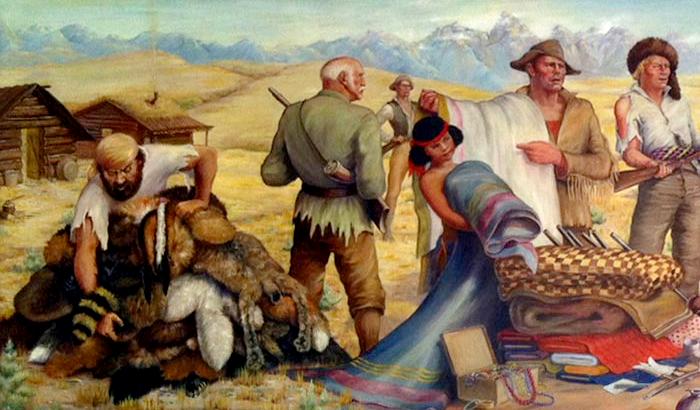
Economic Sectors: The Fur Trade

Figure 1.--This mural, 'The Fur Traders' was painted by Elizabeth Lochrie. It pictures the American fur trade in the early-19th century. TheAmericans bith trapped animals and traded with the Native americans for the pelts they tapped. Lochrie depicts trading at a Native american village. We see both the furs offered by the Native Americans and the trade goods brought by the Americans. It was done as part of the WPA Artists Project. Artists painted murals for public buildings. This was done for the St. Anthony, Idaho Post Office. What is now Idaho was one of the Rocky Mountain states active in the fur trade. Put your cirsor on the image to see the Native American side of the mural.
|
|
The fur trade is a worldwide industry dealing in obtaining and marketing animal fur. It is primarily a northern hemisphere activity because this is wearing the fur-bearing amimals are located and where the demand for warm clothing such as fur coats is strongest. The fur trade played a key role in the movement east of the Norsemen (Vikings) and the foundation of modern Russia. The Vikings also moved west, but as they did not colonize North aneric, the fur trade was not a factor. In modern times with the economic development of Western Europe where people could best afford expensive, fashionable clothing using animal fur. The industry was of huge economic importance (16th-19th centuries) and played a major role in the exploration and colonization of Siberiaand North America. Russia at first dominated the fur trade. And as the market increased in Europe, this drove the Russian expansion east into Siberia and eventually even Pacific North America (Alaska). The same dynamic was at play in Europe. Portraits of European royalty often show fur items. Ermine in particular became a symbol of royalty. Russian domination of the fur trade and the high prices thay demanded was a factor in motivating the Europeans to seak out alternative supplies which of course meant sailing west to North America.
A trickle of pelts from Portuguese, Baque, and Spanish fishermen operating on the Grand Banks alerted Europeans to North America as a source of furs. The Danes, English/British, French, and Swedes were involved (17th century), but the struggle for North America came down to a conlict between the English and French. The fur trade was the most valuable activity in French Canada. The British answered by moving into the Hudson Bay area. In the end, it would be the larger settler popultion in the British Atlantic Coast colonies with its more diverse and dynamic economy and the Royal Navy that would settle who controlled North America in the French and Indian War (1754-63). Ben Franklin's beaver hat would help cement his image and successful diplomacy in France (1777-78). America became more strongly involved after the Louisian Purchase which opened up the rich fur bearing areas of the Rocky Mounains (1803). The famed montain men paddling up the Missouri River would be the beginning of the settlement of the West beyond the Mississippi. While te trapers were after various animals, it was the beaver that was the backbone of the fur trade. Beaver pelts were used for hats in the 19th century, especially the iconic stove-pipe hat. We notice an very young unidentified American boy in the 1850s with a beaver hat done as what loooks like a sterson.
HBC

Navigate the Boys' Historical Clothing Web Site:
[Return to the Main Economic Sector page]
[Return to the Main Economics page]
[About Us]
[Introduction]
[Biographies]
[Chronology]
[Climatology]
[Clothing]
[Disease and Health]
[Economics]
[Freedom]
[Geography]
[History]
[Human Nature]
[Ideology]
[Law]
[Nationalism]
[Presidents]
[Religion]
[Royalty]
[Science]
[Social Class]
[Bibliographies]
[Contributions]
[FAQs]
[Glossaries]
[Images]
[Links]
[Registration]
[Tools]
[Children in History Home]
Created: 3:08 PM 10/4/2017
Last updated: 3:08 PM 10/4/2017



